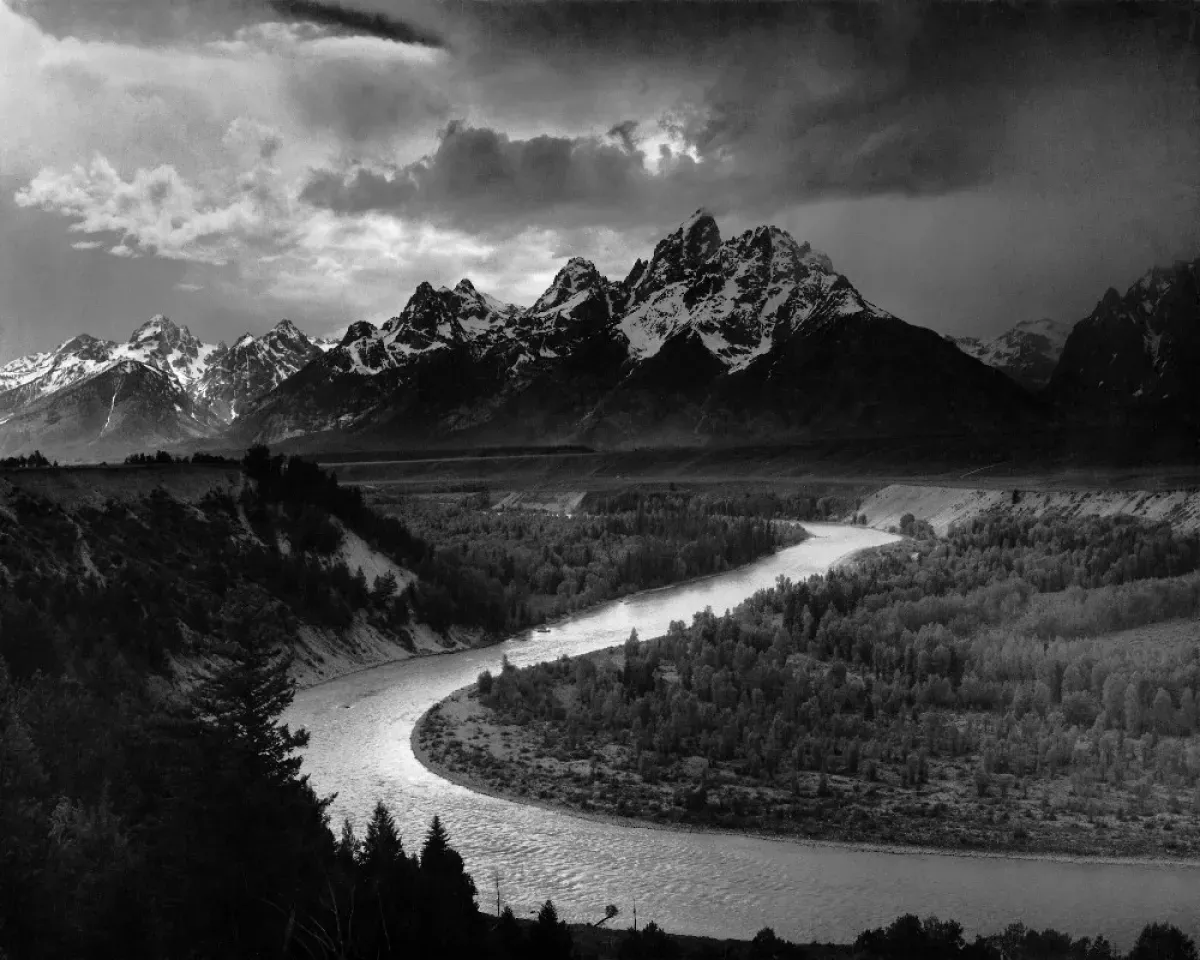The Snake River, a major river in the Pacific Northwest, stretches approximately 1,080 miles (1,740 km), making it the largest tributary of the Columbia River. Originating in Yellowstone National Park, Wyoming, it traverses the Snake River Plain in southern Idaho, carves through Hells Canyon bordering Idaho, Oregon, and Washington, and meanders through the Palouse Hills of southeastern Washington. Ultimately, it converges with the Columbia River downstream from the Tri-Cities, Washington, in the southern Columbia Basin. Its journey showcases diverse landscapes, from arid plains and rugged canyons to rolling hills, highlighting its significance in the region.
1900: I. B. Perrine Files Water Claim
In 1900, I. B. Perrine filed a claim for water from the Snake River, which led to the development of the Milner Dam and a large irrigation project.
1901: Swan Falls Dam Construction
The first small hydroelectric plant on the Snake River, Swan Falls Dam, was built in 1901.
1902: American Falls Hydroelectric Plant Construction
A hydroelectric plant at American Falls on the Snake River was constructed in 1902.
1902: Congressional Provision for Federal Reclamation Projects
Following the failures of private canal companies, Congress made provisions for federal reclamation projects after 1902.
1902: Reclamation Service Created
The Reclamation Service (now the Bureau of Reclamation) was created in 1902, marking the start of increased federal involvement in water resource development.
1905: Wallowa Lake Sockeye Extirpation
By 1905, the Wallowa Lake sockeye salmon run, once numbering 24,000-30,000 adults, was eliminated due to overfishing and unscreened irrigation diversions.
1905: Milner Dam and Canal System Completed
The Milner Dam and its associated canal system, a successful private irrigation project, were completed in 1905, transforming the landscape and leading to the growth of Twin Falls.
1906: Minidoka Dam Construction Begins
Construction began on the Minidoka Dam in 1906, the first federal reclamation project in Idaho.
1907: Shoshone Falls Hydroelectric Plant Construction
I. B. Perrine built a hydroelectric plant at Shoshone Falls in 1907 after developing the Milner Dam irrigation scheme.
1908: Railroad to Lewiston
In 1908, the Union Pacific and Northern Pacific Railroads completed a shared rail line to Lewiston, further diminishing river traffic.
1910: Salmon Falls Hydroelectric Plant Construction
A power plant was built at Salmon Falls in 1910 by small private utilities.
1912: Thousand Springs Hydroelectric Plant Construction
A hydroelectric plant was built at Thousand Springs in 1912 by small private utilities.
1912: Open River Transportation Company Bankruptcy
The Open River Transportation Company, which operated steamboats between Lewiston and Celilo Falls, went bankrupt in 1912.
1915: Idaho Power Incorporated
Idaho Power was incorporated in 1915 and later acquired several existing power plants on the Snake River.
1915: Arrowrock Dam Completed
In 1915, the Arrowrock Dam on the Boise River was completed. At the time it was the tallest dam in the world.
1915: Celilo Canal Completion
The completion of the Celilo Canal in 1915 facilitated steamboat travel between Lewiston and Portland, though railroads remained more competitive.
1920: Last Steamboat on Lower Snake
The last steamboat on the lower Snake River ran in 1920, marking the end of a significant era of river transportation.
1921: Second Shoshone Falls Hydroelectric Plant Construction
A second, larger hydroelectric plant was built at Shoshone Falls in 1921 by Idaho Power.
1924: Payette Lake Sockeye Blocked
The construction of Black Canyon Dam in 1924 blocked the Payette Lake sockeye salmon population, which had once numbered up to 100,000.
1935: Twin Falls Hydroelectric Plant Construction
Idaho Power constructed a hydroelectric plant at Twin Falls in 1935.
1938: Bonneville Dam Improvements
The IEWA initially pushed for improvements like bigger locks at Bonneville Dam in 1938 to improve river navigation.
1941: First Snake River Development Bill
A bill authorizing the Army Corps to develop the lower Snake River was first introduced in Congress in 1941, but it failed.
1945: Snake River Development Authorization
Congress finally authorized the Snake River development in 1945, initially planning for six to ten low dams, later reduced to four larger dams.
1947: Idaho Power's Proposal
In 1947, Idaho Power proposed a series of three medium-sized dams in the upper section of Hells Canyon.
1947: Moratorium on Dam Construction Proposed
In 1947, the U.S. Department of the Interior proposed a ten-year moratorium on dam construction to study the impact on fisheries.
1948: Cascade Dam Construction
Cascade Dam was built in 1948, increasing water storage for the Boise Project.
1950: Anderson Ranch Dam Construction
Anderson Ranch Dam was completed in 1950, further expanding water storage capacity for the Boise Project.
1955: Federal Power Commission Authorization
In 1955, the Federal Power Commission authorized the Idaho Power project, initially approving only the construction of Brownlee Dam.
1955: Construction of Ice Harbor Dam Begins
Senator Warren G. Magnuson pushed through a budget amendment in 1955 to begin construction on Ice Harbor Dam, the first of the four lower Snake River dams.
1956: Construction Begins on Lower Snake Dams
Construction on the lower Snake River dams began in 1956, following the approval of funding for Ice Harbor Dam.
1956: Salmon Trapping at Brownlee Dam
From 1956 to 1964, adult salmon returning to spawn were trapped at the base of Brownlee Dam and released upstream due to the dam's height, which made a fish ladder impractical.
1956: Palisades Dam Construction
Palisades Dam was constructed in 1956, providing flood control and irrigation for the Snake River above Idaho Falls.
1958: Brownlee Dam Completion
Brownlee Dam, the first of the three proposed dams by Idaho Power, was completed in 1958.
1960: Fish Hatchery Proposal
In 1960, Idaho Power proposed abandoning fish passage altogether at its dams and compensating for the loss by building fish hatcheries.
November 29, 1961: Minimum Discharge Recorded at Ice Harbor Dam
On November 29, 1961, the minimum daily mean discharge of the Snake River at Ice Harbor Dam was 2,000 cubic feet per second.
1962: Ice Harbor Dam Completion
Ice Harbor Dam, the first of the lower Snake River dams, was completed in 1962.
1962: Discharge Measurement Begins at Ice Harbor Dam
In 1962, the U.S. Army Corps of Engineers began measuring the discharge of the Snake River at Ice Harbor Dam.
1964: High Mountain Sheep Dam Authorization
In 1964, the Federal Power Commission authorized the High Mountain Sheep Dam project, proposed by the Pacific Northwest Power Company, despite growing public opposition due to its potential impact on salmon migration and the environment.
1964: End of Salmon Trapping
The practice of trapping and releasing salmon at Brownlee Dam ended in 1964.
1965: Record High Mean Annual Discharge
In 1965, the Snake River reached a record high mean annual discharge of 86,240 cubic feet per second.
1966: Hatchery Plan Agreement
In 1966, Idaho Power reached an agreement with the Federal Power Commission to proceed with the fish hatchery plan instead of providing fish passage at its dams.
1967: Hells Canyon Dam Completion
In 1967, the Hells Canyon Dam was completed, marking the upstream limit for migrating salmon.
1967: Udall v. Federal Power Commission Ruling
In 1967, the Supreme Court's landmark ruling in Udall v. Federal Power Commission temporarily halted the High Mountain Sheep Dam project and, for the first time, cited environmental protection as a factor in dam project approvals.
1968: Marmes Rockshelter Flooded
The Marmes Rockshelter, an archeological site along the lower Snake River, was flooded in 1968 due to the construction of the Lower Monumental Dam.
1969: Lower Monumental Dam Completion
Lower Monumental Dam was completed in 1969, despite controversy surrounding the flooding of the Marmes Rockshelter archeological site.
1970: Little Goose Dam Completion
Little Goose Dam was completed in 1970.
1971: Last Whitewater Log Drive
The Clearwater River hosted the final whitewater log drive in the United States in 1971, marking a significant moment in the history of logging in the region.
1973: Dworshak Dam Completion
Dworshak Dam, another controversial dam with no fish passage, was completed in the Clearwater River basin in 1973.
June 19, 1974: Peak Discharge Recorded at Ice Harbor Dam
On June 19, 1974, the maximum recorded daily mean discharge of the Snake River at Ice Harbor Dam was 305,000 cubic feet per second.
1975: Hells Canyon Wilderness Act
In 1975, President Gerald Ford signed the Hells Canyon Wilderness Act into law, effectively ending the High Mountain Sheep Dam project.
1975: Lower Granite Dam Completion and Asotin Dam Deauthorization
Lower Granite Dam, the fourth lower Snake River dam, was completed in 1975. The same year, Congress deauthorized the proposed Asotin Dam project due to public opposition.
1976: Teton Dam Failure
The Teton Dam failed catastrophically in 1976, causing significant loss of life and property damage, impacting the Henrys Fork and Snake Rivers. This event marked a turning point in irrigation development policy.
1980: Northwest Power Act Passed
Congress passed the Northwest Power Act in 1980, mandating federal agencies in the Northwest to mitigate the environmental impacts of their dams on fish and wildlife.
1991: Snake River Sockeye Listed as Endangered
In 1991, Snake River sockeye salmon were officially listed as endangered due to severely declining populations.
1992: Chinook Salmon Listed as Threatened
Spring, summer, and fall-run chinook salmon were listed as threatened in 1992 following population declines after the construction of dams on the lower Snake and Columbia Rivers.
1995: Coho Salmon Reintroduction
Coho salmon, which had vanished from the Snake River by the 1980s, were reintroduced to the watershed in 1995.
1997: Steelhead Listed as Threatened
Snake River steelhead were listed as threatened in 1997, mirroring the decline of chinook salmon populations.
1997: Record Low Mean Annual Discharge
The Snake River experienced a record low mean annual discharge of 27,890 cubic feet per second in 1997.
2000: Unsteady Recovery of Chinook and Steelhead
Despite continued declines into the 1990s, wild chinook salmon and steelhead began an unsteady recovery starting in 2000, with returns sometimes reaching 20,000-30,000.
2000: Decline in Commercial Shipping
Since 2000, commercial shipping tonnage on the Snake River has decreased, mainly due to a pipeline replacing petroleum product shipments. Other sectors also experienced slow recovery after the Great Recession.
2000: Renewed Calls for Dam Removal
Starting in 2000, there were renewed calls to remove the lower Snake River dams, sparking a significant political debate in the Pacific Northwest.
2007: Hells Canyon Complex Contribution
As of 2007, the Hells Canyon Hydroelectric Complex accounted for 40% of Idaho Power's total power generation.
2007: Low Hatchery Fish Survival Rate
Between 2007 and 2016, data from Lower Granite Dam revealed a low survival rate for hatchery-raised chinook (0.4%) and steelhead (1.5%), despite annual releases of about 33 million smolt.
2015: Shift in Shipping Trends
Container shipping at the Port of Lewiston stopped in 2015 because the Port of Portland, its main source, ceased receiving containers. From 2015 to 2023, grain exports from Lewiston remained relatively consistent, while breakbulk cargo saw an increase.
2016: Low Hatchery Fish Survival Rate
Between 2007 and 2016, data from Lower Granite Dam revealed a low survival rate for hatchery-raised chinook (0.4%) and steelhead (1.5%), despite annual releases of about 33 million smolt.
2020: Barge Traffic on the Lower Snake River
In 2020, the Snake River saw 4.2 million short tons of cargo transported by barge, primarily grain, along with forestry products, fuel, chemicals, and fertilizers.
2021: Mike Simpson's Dam Removal Proposal
In 2021, Representative Mike Simpson proposed an ambitious plan to remove the Snake River dams. This proposal also included a 35-year moratorium on litigation related to anadromous fish at federal Columbia River Basin dams.
December 2023: Biden Administration Supports Columbia Basin Restoration Initiative
In December 2023, the Biden administration expressed support for the Columbia Basin Restoration Initiative, which aims to find replacements for the power and navigation functions of the Snake River dams and investigate post-dam river restoration. This initiative doesn't authorize dam removal, which would need Congressional approval.
2023: Over $17 Billion Spent on Salmon Recovery
As of 2023, over $17 billion has been spent on Snake River salmon recovery and hatchery operations.
2023: Continued Shift in Shipping Trends
From 2015 to 2023, grain exports from Lewiston remained relatively consistent, while breakbulk cargo saw an increase.
2023: End of Discharge Measurement Period
The provided text mentions discharge measurements at Ice Harbor Dam until 2023.
Mentioned in this timeline

An empire is a political structure consisting of a dominant...

Snakes are limbless reptiles belonging to the suborder Serpentes They...

War is defined as an armed conflict involving the organized...

A supreme court the court of last resort in many...

Travel involves the movement of people between geographical locations using...

Domestic sheep are quadrupedal ruminant mammals typically kept as livestock...
Trending

1 month ago Dubai Overtakes New York as Top Destination for the World's Wealthy Elite.
1 month ago Kim Woo-bin and Shin Min-ah announce marriage after 10 years of dating.

2 months ago LoL Worlds 2025: T1 vs Gen.G Final Forecasted to Break Viewership Records

1 month ago Sadie Sink avoids Spider-Man spoilers, shows abs. Holland's mistakes provide lessons.

22 days ago Salma Hayek stuns in velvet dresses showcasing Old Hollywood glamour and Kahlua partnership.
4 months ago Uber faces scrutiny over safety record and sexual assault allegations, raising concerns.
Popular

Candace Owens is an American conservative political commentator and author...

Tucker Carlson is an American conservative political commentator known for...

XXXTentacion born Jahseh Dwayne Ricardo Onfroy was a controversial yet...

Kashyap Pramod Patel is an American lawyer who became the...

Ilhan Omar is an American politician currently serving as the...

Bill Gates an American businessman and philanthropist revolutionized personal computing...
